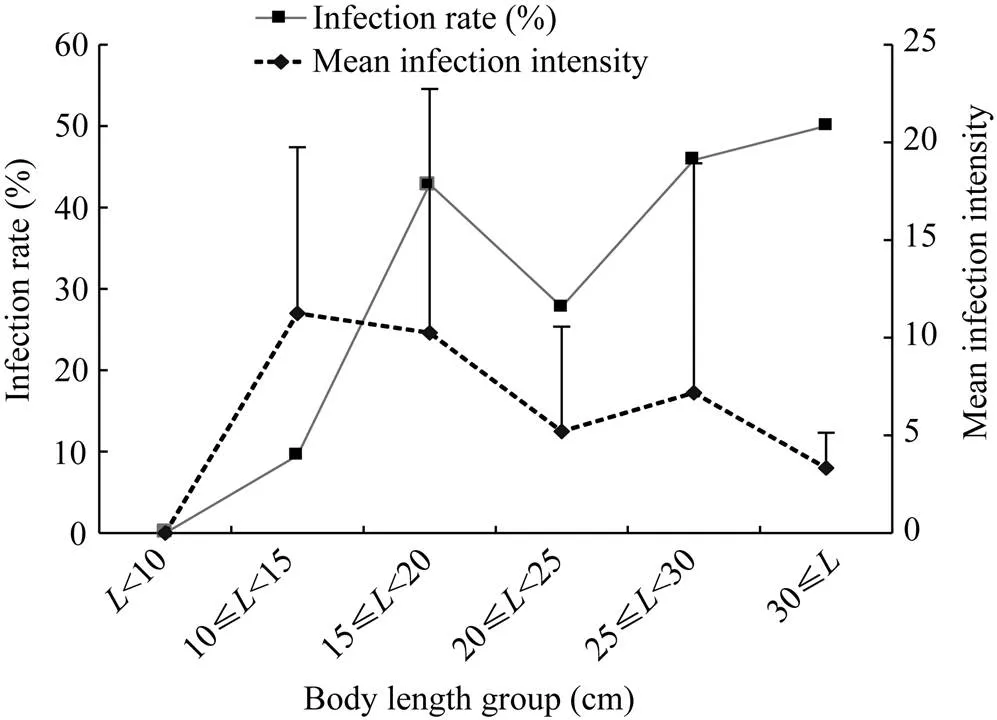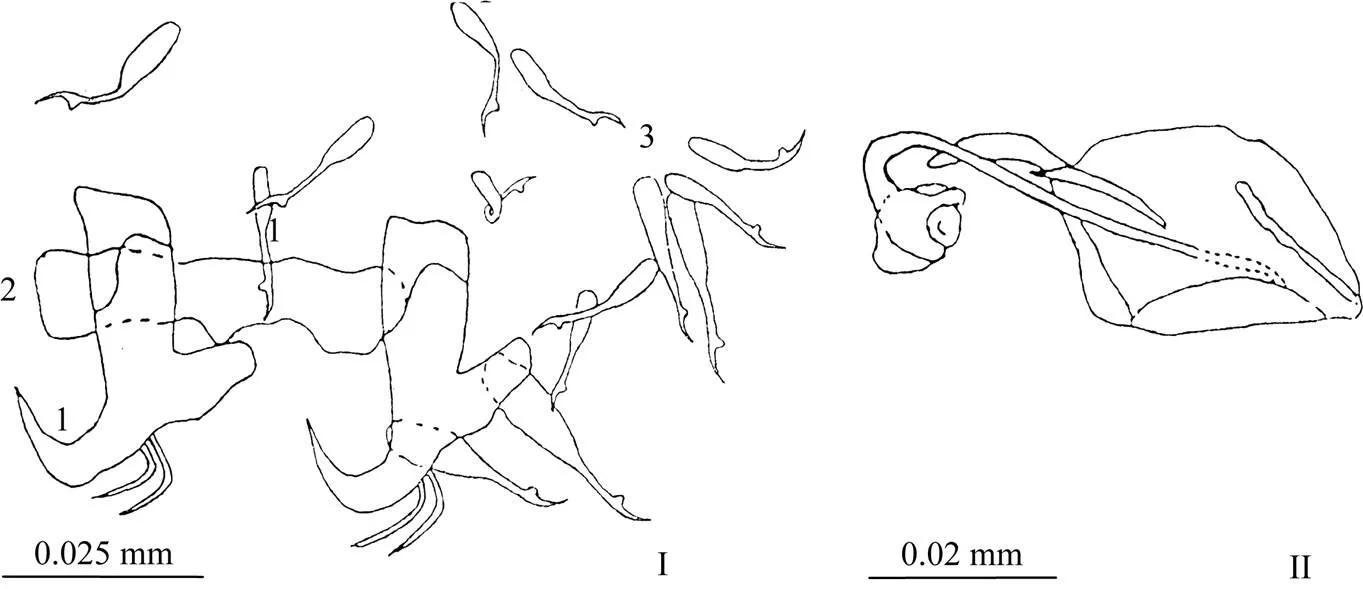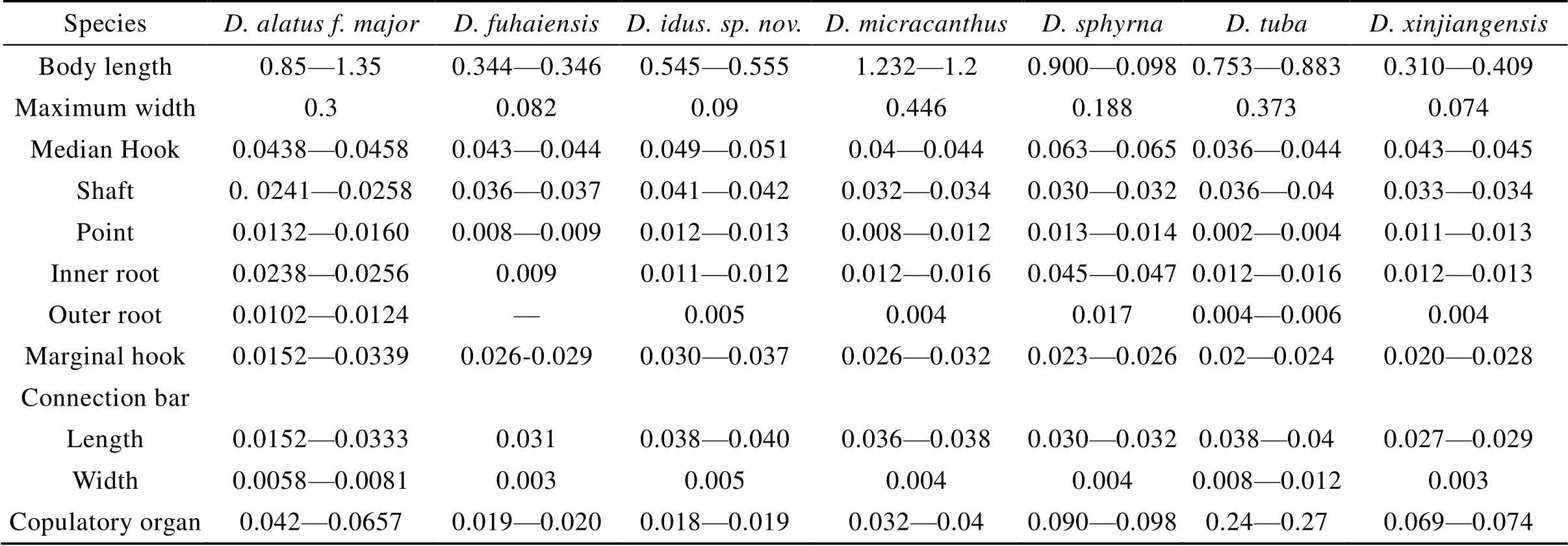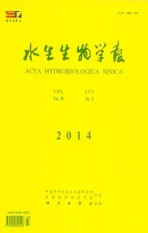POPULATION DYNAMICS OF DACTYLOGYRUS AND A NEW RECORD ON DACTYLOGYRUS IN LEUCISCUE IDUS LINNAEUS IN IRTYSH RIVER OF CHINA
2014-05-27HAOCuiLanYUEChengYAOWeiJianYINJianGuoJIAOLiZHUMengYingandWANGXin
HAO Cui-Lan, YUE Cheng, YAO Wei-Jian, YIN Jian-Guo, JIAO Li, ZHU Meng-Ying and WANG Xin
POPULATION DYNAMICS OF DACTYLOGYRUS AND A NEW RECORD ONINLINNAEUS IN IRTYSH RIVER OF CHINA
HAO Cui-Lan1, YUE Cheng1, YAO Wei-Jian2, YIN Jian-Guo3, JIAO Li4, ZHU Meng-Ying1and WANG Xin1
(1. College of Veterinary Medicine, Xinjiang Agricultural University, Urumqi 830052, China; 2. Institute of Hydrobiology, Chinese Academy of Sciences, Wuhan 430072, China; 3. The Irtysh River Specialty Fish Ambulance Center of 10th Agricultural Division of the Production and Construction Corps of Xinjiang, Beitun 836000, China; 4. College of Animal Science, Xinjiang Agricultural University, Urumqi 830052, China)
This paper revealed the population dynamics ofon the gills ofLinnaeus by field investigation from April 2009 to July 2012 in Irtysh RiverThe results showed that threespecies infectincludingand, and their infection rate was 28.47% and mean infection intensity was 7.39 (1—42). The prevalence was varying among host body length () groups, as the infection rate was the highest (50%) in>30 cm, but thewas zero in<10 cm.was in the aggregation distribution mode in different groups. The infection intensity showed no significant difference (>0.05) among different groups. Population ofin host was aggregated distribution in different groups. AofLinnaeus was collected from the Irtysh River, Northwest China. The specimens were identified asLinsyow (1878) according to morphological characteristics, and represent the first record in China. The main morphological characteristics were described and drawn, and also compared to those from the gills of other species ofin China.
;; Population dynamics;; New record
Irtysh River originates from the Sino-Mongolian border and locates in the abdomen of Eurasia. Its upstream locates in the northeastern part of theAltaiMountains in Xinjiang of China. With a length of 633 km and a drainage area of 53700 km2, it is one of the three major rivers in Xinjiang and the only Arctic drainage international river in China[1]. Because of development formation, geographic landform characteristics and multifarious downstream drainage features, Irtysh River has gestated some special fishes, such asLinnaeus, which distribute in Europe, Northwest Asia, and China (restricted to Irtysh River and its subsidiary waters)[2]. The parasitism of,andin fish gill department of Monogenea, Dactylogyridae Bychowsky, and Dactylogyrus Diesing can cause certain harm to the host[3],andwere first discovered in Irtysh River in China in 2009, reported in 2011, and already described by some authors[4], butwas collected fromgills, which has not been reported[3—8]. After identification according to the unreported data retrieval in China[3, 5, 7—9],belongs to Dactylogyridae, Dactylogyrus, as China’s new Monogenea record. The specimens were observed under optical microscope (measurements in mm) and a diagram about its characteristics was drawn. The specimens are preserved in Parasite Specimen Room, Animal Veterinary College of Xinjiang Agricultural University.
1 Materials and Methods
was collected from Ha Bahe and Bei Tun reaches of Irtysh River basin. After the host gills were taken down and physiological saline was dropped in glass, parasites were picked up in anatomical lens and fixed with 75% alcohol. The parasites were fixed as seal pieces by 4% poly (vinyl alcohol) lactic phenol, their chitin structure was measured under microscope, and a characteristic diagram was drawn. The specific species were identified on the basis of literature[3—13].
was divided into 6 body individual length () groups:<10 cm, 10 cm≤<15 cm, 15 cm≤<20 cm, 20 cm≤<25 cm, 25 cm≤<30 cm, 30 cm≤, Statistics for each body length group ofincludes prevalence, average infection intensity, variance-mean ratio2/, parameter of negative binomial distribution, average degree of congestion, and diffusivity index. T-test was used to detect the significance of inter-group difference in the infecting effect ofon the hosts[14].
2 Results
2.1 Infection of Dactylogyrusin Leuciscus idus
Of the 144Linnaeus collected from April 2009 to July 2012, the prevalence of infection by Dactylogyruswas 28.47%. During this period, 303 specimens ofwere examined including,,. The number ofin a fish was about 42 at most. The body length () ofLinnaeus was divided from small to large into different groups every 5 cm. The results showed that in<10 cm,was not found. The highest infection rate of host was in 30 cm<, but the infection intensity was relatively low. Infections of the different body length groups ofLinnaeus were shown in Fig.1.
The significance test results of infection intensity differences in different length groups ofLinnaeus were shown in Tab. 1. In terms of infection intensities between segments, the visible host of<10 cm differed significantly from 15≤<20 cm, and 30 cm≤, but no significant differences existed in the rest body length groups.
2.2 Aggregation Index of Dactylogyrusin Leuciscus idus
The diffusion index () means crowding degree() and variance-to-mean ratio (²/) were greater than 1 in each length group except<10 cm; the distribution type was measured according to the judgment of population ecology, and the results showed that Dactylogyrus was in aggregated distribution in each body length group. Values of negative binomial parameter () were different among different body length groups and showed different aggregation intensities of Dactylogyrus population. The population distribution pattern of Dactylogyrus inwas shown in Tab. 2.

Fig. 1 Infection rate and mean infection intensity of Dactylogyrus in different body length group
2.3 Dactylogyrus alatus, Linsyow, 1878 f. major Sidorov 1956 (Fig. 1)
The host:Linnaeus, and Site of infection: Gill filaments Locality: Habahe River of Irtysh River reach (48°05′–48°10′ N, 86°32′–86°37′ E).Acquisition time: 2009—2012.
Description: Large worms have a length of 0.85— 1.35 mm and a width of 0.21—0.30 mm. Length of hooklet: 0.0152—0.0339 mm. Median hooks were massive, with powerful processes, particularly inner processes, which expand terminally; their length equaled to base or larger, and external process were at least half as large as base. Median hooks had an overall length of 0.0438—0.0458 mm, a shaft of 0.0241—0.0258 mm, point of 0.0132—0.0160 mm, inner root of 0.0238— 0.0256 mm, and outer root of 0.0102—0.0124 mm. Connecting bar: (0.0058—0.0081)×(0.0152—0.0333) mm. Copulatory organ: about 0.042—0.0657 mm, diameter of tube: over 0.0015 mm (Fig. 2).

Tab.1 Significance test of infection intensity among the different host body length groups of Leuciscus idus

Tab. 2 The aggregation indices of Dactylogyrusamong different body length groups of Leuciscus idus
Morphological description:
2.4 The main morphologic characteristics ofwere compared to those from the gills of other species ofLinnaeus in China (Tab. 3)
3 Discussion
Monogenea belongs to platyhelminthes and chooses fish as the main parasitic object. It has a wide range, diverse morphology, and a high degree of specificity to the host. Monogenea is also a good material to study the formation of species, common evolution, structure and function, ontogeny, ultrastructure, experimental ecology animal geography and other relevant issues. At present a lot of Monogenea has been reported[4,15—19].
Sampling statistics showed thatwas infected by three Dactylogyrus species:,, and. The total infection rate andthe mean infection intensity ofwere 28.47% and 7.39, respectively, and were relatively small. The study showed that environmental factors that affect Monogenea included light, temperature, oxygen, host and water. Since Monogenea mainly parasitizes hosts in vitro, the low temperature conditions are detrimental to their breeding, development and growth[3]. Irtysh River has a cold continental climate, high latitudes, a sunshine rate of 62.0%—71.0%, and slightly alkaline pH in tributaries and the main stream. Its hydrochemical type is heavy carbon salt, calcium and II-type, and the basin during floods is relatively large[1]. The survey showed that total infection rate and infection intensity of Dactylogyrus were low in thepopulations, because the Irtysh River’s low water temperature, flow and water chemistry type are not conducive to the breeding and growth of Dactylogyrus.

Fig. 2 Dactylogyrus alatus f. major, Linsyow, 1878
I: Opisthohapter elements: 1.Median hook; 2.Connecting bar; 3.Marginal hooklet; II: Copulatory organ

Tab. 3 Measurements of the new record compared to species recorded from L. idusLinnaeus in China (mm)
Note: “—” means no data
The statistics of Dactylogyru on different host body length groups shows that, with the increase of host body length, the Dactylogyrus infection rate has gradually increased except for 20≤<25, and the infection intensities were decreased, except<10 which showed no infection. The water ecological environment in Irtysh River and the interspecific competition of parasites impact the above characteristics. Although the cold water environment of Irtysh River is not conducive to survival of Dactylogyrus, Irtysh River Basin enjoys species diversity and biomass, and this environment has created favorable conditions for the development and reproduction of fish parasites. Therefore, there are many differences and infection characteristics between the types of parasites[1]. The survey shows that three Dactylogyrus were detected in the gills of. And the infected host populations were in an aggregated distribution mode, indicating that the majority of the host is not or infected with a small amount of Dactylogyrus. A large number of Dactylogyrus parasitize in the relatively minority of host, sois lower, and the gathering strength is higher[20]. Aggregated distribution is the most common distribution mode, so the vast majority of the parasite populations in their host populations also showed aggregated distribution. This also means the effects of parasite on host populations will be minimized[21]. The three Dactylogyrus parasites on the gills of host all belong to the resource (niche), the use of a competitive relationship. In most cases, the parasites compete for living space niche, and the community structure in the different life stages of the host may vary[22]. The reason may be that the parasite’s parasitization makes the host weak and thus more susceptible to other parasites. It may also be that a parasite prepares another parasite for microenvironment.
Many types of Monogenea were found in China’s inland water bodies[3]. In China, more than 570 species of Monogenea were found, and they belong to 9 families and 46 genera. The widest range is Dactylogyridae, which accounts for about 63% of Monogenea and the most diverse is Dactylogyrus. Dactylogyrus has 600 species in the world and more than 370 species in China, buthas not been reported by the data retrieval in China[3, 5].
Irtysh River locates in Northwest China, the center of the hinterland of Eurasia. It flows from east and west to the frontier, enters into the Lake Zaysan, gathers at the Ob River and flows to the Arctic Ocean, which is different from the continental rivers in Xinjiang that constitute a natural feature of centripetal drainage. From the division of world freshwater fishes, it belongs to the north boundary, the whole north district, circumference pole subregion of Siberian partition, and frontal river. The Arctic cold water fishes migrating to the upstream tributary have egg-laying habits[23], so the Arctic drainage fishes that carry a parasite may appear in the upstream. This in certain conditions causes the fish parasites flora composition in frontal river (China section), which is similar to the parasites of central Asia and Europe, but different from Chinese inland water parasities.belongs to Cypriniformes, Cyprinidae, and Leuciscus subfamily, which is distributed from northern Europe to Siberia drainage, and in China it only distributes in Xinjiang Irtysh River within the territory of the main stream, which is one of the major native Irtysh fishes. The historic distribution ofis almost the same as, and this should be caused by the host’s migration. Under certain conditions, the Arctic drainage fish that carries a parasite may appear in the upstream. To a certain extent it determines that the flora composition of fish parasites in Irtysh River (China section) is different from that of domestic water fish parasites. So within the territory of China, in the upstream section and middle and lower reaches of Siberia, it will not be surprising there is a common fish composition and parasitic species. The discovery ofprovides a powerful evidence for fish classification in Irtysh River, and meanwhile, this will also provide new scientific basis for further study between hosts, the genetic relationship of geographic evolution between parasites and hosts, and ecological pattern.
Generally, most Dactylogyrus has high host specificity, and some even has strict host specificity (a parasite is parasitic only to a host), so host specificity plays a unique role in identification of parasite types[3]. A survey of nearly 30 fish species in the Irtysh River found thatonly parasitizesin Irtysh river (China section), but in foreign countries it was also found to parasitize Leuciscusbaicalensis Dybowski, 1874 gills[6],, and white bream[24—25]. Our investigation did not findon the gills of. This may be related to the number and size of the acquired hosts, and the small number of parasites in the river basins. The relationship betweenand the hosts in Irtysh River basin needs further research.
[1] Ren M L, Guo Y, Zhang R M,. The Fish Resources and Fishery in Ergis River, China [M]. Urumqi: Technology Hygiene Xinjiang Press. 2002, 1—226 [任慕莲, 郭焱, 张人铭, 等. 中国额尔齐斯河鱼类资源及渔业. 乌鲁木齐: 新疆科技卫生出版社. 2002, 1—226]
[2] Ren M L, Guo Y, Zhang R M,. Fishes and fish fauna composition in Ergis River, China [J]., 2002, 19(2): 62—66 [任慕莲, 郭焱, 张人铭, 等.我国额尔齐斯河的鱼类及鱼类区系组成. 干旱区研究, 2002, 19(2): 62—66]
[3] Wu B H, Lang S, Wang W J,. Fauna China, Platyhelminthes, Monogenoidea [M]. Beijing: Science Press. 2000, 1—756 [吴宝华, 郎所, 王伟俊, 等. 中国动物志, 扁形动物门, 单殖吸虫纲. 北京: 科学出版社. 2000, 1—756]
[4] Zhao J S, Yao W J, Jiao L,. Two new records of Monogenenoidea fromLinnaeus in Ergis river, China [J]., 2011, 35(4): 713—716 [赵江山, 姚卫建, 焦丽, 等. 额尔齐斯河高体雅罗鱼单殖吸虫中国二新记录种. 水生生物学报, 2011, 35(4): 713—716]
[5] Wu B H, Sun X D, Song C C. Fauna of Zhejiang (Trematoda) [M]. Hangzhou: Science Technology Press. 1991, 1—416 [吴宝华, 孙希达, 宋昌存. 浙江动物志(吸虫类).杭州: 浙江科学技术出版社. 1991, 1—416]
[6] Gusev A V. Key to the Parasites of Freshwater Fish Fauna of the USSR. (Volume 2) [M]. Leningrad Science Publishing Company. 1985, 62—63
[7] Xia X Q, Wang W J, Yao W J. The composition of monogenea in inland waters of China [J]., 1999, 25(1): 57—61 [夏晓勤, 王伟俊, 姚卫建. 中国内陆水体单殖吸虫的种类组成. 湖南农业大学学报, 1999, 25(1): 57—61]
[8] Institute of Hydrobiology, Chinese Academy of Sciences. Illustrated Record on Pathogen Flora of Fish Disease in Hubei [M]Beijing: Science Press. 1973, 1—456 [中国科学院水生生物研究所. 湖北省鱼病病原区系图志. 北京: 科学出版社, 1973, 1—456]
[9] Pan J H, Zhang J Y, Li Z C,. Fish Parasitology [M]. Science Press. 1990, 1—443 [潘炯华, 张剑英, 黎振昌, 等. 鱼类寄生虫学. 北京: 科学出版社. 1990, 1—443]
[10] Ichthyopathology Laboratory, Institute of Hydrobiology, China Academy of Sciences. The Handbook of Fish Disease Examination (second edition) [M]. Shanghai: Shanghai Science Technology Press. 1985, 1—278 [中国科学院水生生物研究所鱼病研究室. 鱼病调查手册. 第2版. 上海: 上海科学技术出版社. 1985, 1—278]
[11] ONDRAČKOVÁ M, MATĚJUSOVÁ I, ŠIMKOVÁ A,. New reports of dactylogyridean species (Monogenea) for Central Europe [J]., 2004, 41(3): 139—145
[12] Shamall M A Abdullah. Additional records of Dactylogyrus (Monogenea) from some cyprinid fishes from Darbandikhan Lake,Iraq [J],2009, 2(4): 145—150
[13] Satyu Y. Systema Helminthum (Volume Ⅳ: Monogenea and Aspidocotrlea) [M]. Interscience Publishers, a Division of John Wiley & Sons, New York, London. 1963, 1—699
[14] Margolis L, Esch G W, Holmes J C,. The use of ecological terms in parasitology (Report of an Ad Hoc committee of the American society of parasitologists) [J]., 1982, 68: 131—133
[15] Ding X J, Pan J, Liu L. Monogenea of Chinese marine fishes a new species of monax-inoides form fishes of the south China sea (Mazocraeidea, Monaxinoididae) [J]., 2003, 28(4): 606—609 [丁雪娟, 潘骏, 刘琳. 中国海洋鱼类单殖吸虫南海似单斧虫属一新种(钩铗虫目, 似单斧虫科). 动物分类学报, 2003, 28(4): 606—609]
[16] Li H Y. Desciption of one new species and one new record ofof fishes from Guangzhou [J]., 2004, 29(2): 234—238 [李海燕. 广州鱼类单殖吸虫似伪指环虫属一新种及一新记录. 动物分类学报, 2004, 29(2): 234—238]
[17] Li H Y, Huang X C. One new Chinese record genera () and one new species and one new recorded of monogenea parasiting on gills of[J]., 2012, 27(2): 116—119 [李海燕, 黄茜春. 下口鲶寄生单殖吸虫中国一新记录属及一新种和一新记录种的记述. 大连海洋大学学报, 2012, 27(2): 116—119]
[18] Wang W B. A new species and two new records of halioterma (Monogenea, Ancyrocephalidea) from marine fishes in Hainan Island, China [J].,2007, 32(1): 17—20 [王文彬. 海南岛海水鱼类寄生海盘虫属一新种及两新记录(单殖亚纲, 锚首虫科). 动物分类学报, 2007, 32(1): 17—20]
[19] Wu X Y, Xie M Q, Li A X. Two new Chinese record genera—cichlidogyrus paperna, 1960 and sutogyruspariselle & Euzet, 1995 (Monogenea, Ancyrocephalidae) [J]., 2006, 31(3): 536—540 [吴相云, 谢明权, 李安兴. 奥尼罗非鱼寄生单殖吸虫中国二新记录属(锚首虫科). 动物分类学报, 2006, 31(3): 536—540]
[20] Li W X, Wang G T. Regulation of parasites on host population: A brief review., 2002, 26(5): 550—554 [李文祥, 王桂堂. 寄生虫对宿主种群的调节. 水生生物学报, 2002, 26(5): 550—554]
[21] Nie P. A brief review on the population ecology of parasites [J]., 1990, 14(4): 359—367 [聂品. 寄生虫种群动态研究的综述. 水生生物学报, 1990, 14(4): 359—367]
[22] Xia X Q, Wang W J. The biology and ecology of monogenea [J]., 1997,21(1): 75—84 [夏晓勤, 王伟俊. 单殖吸虫生物学及生态学. 水生生物学报, 1997, 21(1): 75—84]
[23] Li S Y, Lei J Q. The Pattern and Change of the Ecosystems in the Ergis River Watershed [J]., 2002, 19(2): 56—61 [李生宇, 雷加强. 额尔齐斯河流域生态系统格局及变化. 干旱区研究, 2002, 19(2): 56—61]
[24] MOLNÁR K. Über die Parasitenfauna der Fische in Ungarn [J]., 1964, 14: 455—467
[25] Prost M. Fish Monogenoidea of Poland. I. Parasites of(L.) [J]., 1972, 20: 233—247
额尔齐斯河高体雅罗鱼指环虫种群动态及中国一新记录种
郝翠兰1岳 城1姚卫建2殷建国3焦 丽4朱梦莹1王 新1
(1. 新疆农业大学动物医学学院, 乌鲁木齐 830052; 2. 中国科学院水生生物研究所, 武汉 430072; 3. 新疆生产建设兵团农十师额尔齐斯河特种鱼救护中心, 北屯 836000; 4. 新疆农业大学动物科学学院, 乌鲁木齐 830052)
2009年4月到2012年7月对额尔齐斯河(中国段)高体雅罗鱼鳃部寄生的指环虫进行了取样调查,以期了解该鱼指环虫的种群生态学特点。结果表明, 高体雅罗鱼共感染了三种指环虫, 分别为号筒指环虫、小刺指环虫、大翼指环虫, 该鱼的总感染率为28.47%, 平均感染强度为7.39 (1—42)。感染率、感染强度在不同体长组的宿主中表现出不同的变化趋势, 指环虫的感染率在30 cm以上的宿主中达到最大, 为50%, 而在<10范围内未发现感染; 在不同体长组宿主中指环虫种群的分布类型主要为聚集分布, 另外, 根据形态学特征鉴定大翼指环虫(Linsyow, 1878)为我国指环虫属一新记录种, 论文对其主要形态特征进行了描述并绘制了特征图, 同时与寄生于高体雅罗鱼鳃上的国内已记述指环虫属虫种的主要形态特征作了比较。
高体雅罗鱼; 指环虫; 种群动态; 大翼指环虫; 新记录
2013-01-05;
2013-11-25
National Science Foundation of China (No.: 31160535), the State Key Laboratory of Freshwater Ecology and Biotechnology (No.: 2011FB06), and the Project of Technology Support Xinjiang (No.: 201191136)
Hao Cui-Lan (1987—), female, ethnicHan, Henan Province, Master, major in prevention veterinary science, E-mail: haocuilan@126.com
Yue Cheng (1958—), male, ethnicHan, Shaanxi Province, Master, E-mail: yuechengxnd@yahoo.com.cn
Q145+.1
A
1000-3207(2014)02-0227-06
10.7541/2013.34
